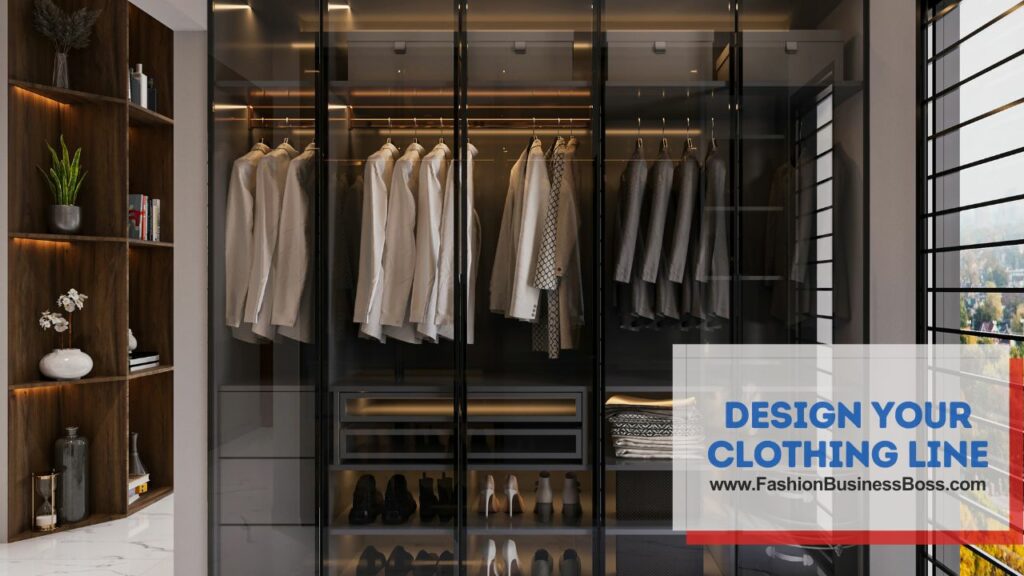Are you passionate about fashion? Do you dream of creating your clothing line and sharing your unique style with the world? Starting a clothing business can be a satisfying venture, allowing you to turn your love for clothing into a stable enterprise.
To start a clothing business, research your niche, create a business plan, secure funding, choose suppliers, design your clothing line, set up an online or physical store, and market your brand effectively to attract customers.
In this article, we will walk you through the step-by-step process of launching your own clothing business.
Find Your Niche: Discovering Your Unique Style

Getting your clothing business off the ground kicks off with something pretty important: figuring out your niche. The fashion world is a big place, and you gotta stand out to make it big. So, think about what gets your fashion senses tingling. Is it laid-back casual stuff, sporty gear, fancy formal attire, or maybe something super unique? Your niche should be all about what you’re passionate about and what you know inside and out.
Next, dive into some market research. You wanna know what’s missing in the fashion scene that you can bring to the table. Keep an eye on what’s hot and what’s not. What do people want? What are their lifestyles like? Your niche has to connect with a specific bunch of people, whether they’re a certain age, gender, or living a particular lifestyle.
Your niche is like your fashion fingerprint – it’s got to be unique to you. Think about your style, your interests, and what gets your fashion senses tingling. Do you love that comfy, laid-back look, or are you more into sporty gear? Maybe you’re all about the super fancy stuff, or perhaps you’ve got something fresh and different in mind. Your niche should be something you’re crazy passionate about and know like the back of your hand.
Once you’ve got your niche nailed down, it’s time to hit the market. You’re like a fashion detective now, looking for gaps and opportunities. What’s the fashion world missing right now that you can swoop in and provide? Keep your eyes peeled for trends, what people are into, and how they live their lives. Your niche should speak directly to a specific group of folks, whether they’re a certain age, gender, or living a particular kind of life.
Remember, your niche is your fashion identity – it’s gotta be one-of-a-kind, just like you. So, think about your style, the stuff you love, and what gets your fashion juices flowing. Maybe you’re all about that comfy, everyday look, or you’re into sporty vibes. Perhaps you’re all about the glitz and glam, or maybe you’ve got something super fresh and new in mind. Your niche should be your fashion passion, something you know inside and out.
Read more about: How to Get Clothes to Sell: Boost Your Income
Create a Business Plan: The Roadmap to Greatness
Alright, let’s break it down. Your clothing business is like a puzzle, and a business plan is a picture on the puzzle box that shows you how it all fits together. It’s super important because it lays the groundwork for everything you do. Here’s what you need in it:
- Executive Summary: This is like a quick intro to your business. It tells people what you’re all about and what you want to achieve.
- Market Analysis: Think of this like being a detective. You’re digging into who your customers are, what your competition is up to, and what’s trendy in the fashion world. This helps you know where you stand.
- Product Line: This is where you spill the beans about your clothes. What are you making? What do they look like? What are they made of? It’s all about showing off your fashion style.
- Marketing Strategy: How are you gonna shout out to the world that you exist? This part is about spreading the word about your brand and getting people excited to buy your stuff.
- Financial Projections: Here, you’re looking into the future. How much money are you going to make? How much will you spend? What do you need to make it all happen? It’s like looking at the financial crystal ball.
- Operations Plan: Think of this as the backstage pass to your clothing show. It’s all about how you’re going to make your clothes, get them to customers, and keep things running smoothly.
- Legal and Regulatory Considerations: Every business has to follow rules. This part is like a checklist for all the legal stuff, like getting the right licenses and making sure you’re playing by the rules.
Now, why is all this important? Well, first, it’s like having a roadmap for your business journey. It helps you stay on track and know where you’re going. Plus, if you ever need money from investors or loans, a solid business plan shows them you mean business and helps you get the support you need.
Secure Funding: Financing Your Clothing Business
Financing is a crucial step in starting a clothing business. Determine your startup costs, which may include purchasing equipment, materials, and marketing expenses. Explore various funding options:
- Personal Savings: Use your savings to kickstart your business.
- Loans and Credit: Consider business loans, personal loans, or credit lines.
- Investors: Seek investors or venture capitalists who believe in your vision.
- Crowdfunding: Platforms like Kickstarter can help you raise funds from the public.
- Grants: Explore grants for fashion entrepreneurs or small businesses.
Choose the funding option that aligns with your financial situation and long-term goals.
Choose Your Suppliers: Sourcing Quality Materials
The quality of the clothes you offer in your business is pretty much connected to where you get your stuff from. So, first off, you gotta do some research and pick suppliers that you can trust to give you the materials and fabrics you want.
Think about things like how much it’s gonna cost you, whether the stuff they provide is top-notch, how long it takes for them to deliver, and also if they’re doing things the right way ethically.
Now, it’s not just about finding the right supplier, it’s about building a strong relationship with them. You want a smooth flow of materials coming in, right? So, talk to your supplier, make sure you’re both on the same page and try to work out good deals that don’t eat into your profits too much. That’s just good business sense.
And here’s the kicker – quality materials are like the secret sauce for your clothing biz. If you’re using top-quality stuff, it’s gonna show in your final products. People notice quality, and it’s gonna leave a good impression on your customers.
So, bottom line, take your time picking the right suppliers, get that relationship going, and always aim for top-notch materials. It’s a winning combo for your clothing business.
Design Your Clothing Line: Unleash Your Creativity

Designing your clothing line is where your creativity takes center stage. Whether you’re a designer yourself or collaborate with one, your designs should reflect your brand’s unique style and vision. Here’s how to approach the design process:
- Sketch and Conceptualize: Start with sketches and concepts that capture your ideas.
- Select Materials: Choose fabrics that align with your designs and customer preferences.
- Prototype and Testing: Create prototypes to test the fit, comfort, and style.
- Production Planning: Plan your production process, considering batch sizes and lead times.
- Quality Control: Implement quality control measures to ensure consistency.
Your clothing line should resonate with your target audience and stand out in the competitive fashion market.
Read more about: How to Have a Clothing Business: Thriving in Fashion
Setting Up Shop: Online or Brick-and-Mortar?
Deciding where to sell your clothing is a critical choice. You can opt for an online store, a physical brick-and-mortar location, or a combination of both. Each option has its advantages and challenges:
- Online Store: Offers a wide reach, lower overhead costs, and convenience. You’ll need an e-commerce platform, reliable shipping, and a strong online presence.
- Physical Store: Provides a tactile shopping experience and immediate brand visibility. It requires a physical location, inventory management, and store design.
Consider your target audience and budget when choosing your sales channels. Many clothing businesses start online before expanding into physical stores.
Marketing Your Brand: Building a Strong Presence
Marketing plays a pivotal role in establishing your clothing brand’s presence and attracting customers. Here are key marketing strategies to consider:
- Branding: Develop a compelling brand identity, including a logo, tagline, and brand story.
- Website and Online Presence: Create a user-friendly website with high-quality product images and descriptions.
- Social Media: Utilize platforms like Instagram, Facebook, and Pinterest to showcase your designs.
- Content Marketing: Publish blogs, articles, and videos that resonate with your target audience.
- Email Marketing: Build a mailing list and send regular updates, promotions, and newsletters.
- Partnerships and Collaborations: Collaborate with influencers, fashion bloggers, or other brands to expand your reach.
Consistency and authenticity in your marketing efforts will help you build a loyal customer base.
Learn and Adapt: Growing Your Clothing Business
Launching a clothing business is just the start of your journey. To make it in the competitive fashion world, you’ve got to keep learning and changing. Here are some ways to keep your business growing:
- Listen to Customers: Pay attention when customers talk. Their feedback can be like gold dust. If they suggest something or have a complaint, take it seriously. Use their input to make your clothes even better.
- Add More Stuff: If your customers are loving what you’re doing, think about adding new designs or different types of clothes they might want. It’s all about giving them more of what they like.
- Get Bigger: If things are going well, consider making more clothes. You might need to up your production or even branch out to new areas. It’s all about growing your business.
- Go Green: These days, lots of folks care about the environment. So, think about using eco-friendly materials or practices. It can make your brand even more appealing to eco-conscious customers.
- Stay in the Know: The fashion world changes fast. Keep an eye on what’s hot, new technologies, and what’s happening in the fashion scene. Being in the loop keeps your business fresh.
Now, here’s the deal – don’t expect to hit the jackpot right away. Growth takes time. Stay patient and keep pushing for improvement. Over time, your dedication and drive will pay off, and your clothing business will grow and thrive.
Summary
Starting a clothing business is a journey that requires dedication, creativity, and a deep understanding of the fashion industry. It’s an opportunity to turn your passion for clothing into a thriving venture. By finding your niche, creating a solid business plan, securing funding, choosing reliable suppliers, designing a unique clothing line, and implementing effective marketing strategies, you can make your mark in the world of fashion.
So, are you ready to take the first step towards making your clothing business dreams a reality? With the right vision and determination, your fashion brand can become a household name, and your designs can inspire countless individuals around the world. Embrace your passion, stay true to your style, and embark on this exciting entrepreneurial journey
Your clothing business awaits!
Frequently Asked Questions

How much money do I need to start a clothing business?
To launch a clothing business, your budget varies based on factors like your niche, scale, and location. Small online startups may need $5,000 to $10,000, while physical stores can require $50,000 or more.
How do I find reliable clothing suppliers?
Research potential suppliers, ask for referrals, attend trade shows, and consider visiting factories. Request samples to assess quality. It’s crucial to establish strong relationships with trustworthy suppliers for a clothing business.
What’s the key to great clothing brand marketing?
Effective marketing involves building a compelling brand identity, utilizing social media, creating engaging content, and fostering customer relationships. Consistency, authenticity, and a deep understanding of your target audience are vital for brand progress.
To learn more about starting your own clothing business, check out my startup documents here.
The information provided by FashionBusinessBoss.com (“The Site”) is for general informational purposes only. All information on the Site is provided in good faith, however, we make no representation or warranty of any kind, express or implied, regarding the accuracy, adequacy, validity, reliability, availability or completeness of any information on the Site. Under no circumstance shall we have any liability to you for any loss or damage of any kind incurred as a result of the use of the Site or Reliance on any information provided on the Site. Your use of the Site and your reliance on any information on the Site is solely at your own risk. This blog post is for educational purposes only and does not constitute legal advice. Please consult a legal expert to address your specific needs. Terms and Conditions. (https://fashionbusinessboss.com/terms-and-conditions/)

Meet Shawn Chun: Entrepreneur and Fashion Business Fan.
I’m a happy individual who happens to be an entrepreneur. I have owned several types of businesses in my life from a coffee shop to an import and export business to an online review business plus a few more and now I create online resources for those interested in starting new ventures. It’s demanding work but I love it. I do it for those passionate about their business and their goals. That’s why when I meet a designer or boutique owner at a craft fair, farmers market, retail location or anywhere else I see myself. I know how hard the struggle is to retain clients, find good employees and keep the business growing all while trying to stay competitive.
That’s why I created Fashion Business Boss: I want to help fashion business owners like you build a thriving business that brings you endless joy and supports your ideal lifestyle.

